#removable dental appliance
Explore tagged Tumblr posts
Text
A few sensible precautions preserve your appliance’s progress and lifetime while preventing tooth decay simultaneously. Monitor for irritation indicating needed tweaks at future visits too. Avoid missing or shortcutting recommended wear hours unless absolutely necessary. Consistency is key with removable orthodontic appliances!
#removable orthodontic retainer#removable orthodontic braces#cost of removable retainers#removable appliance#removable orthodontic appliances#removable dental appliance
0 notes
Text
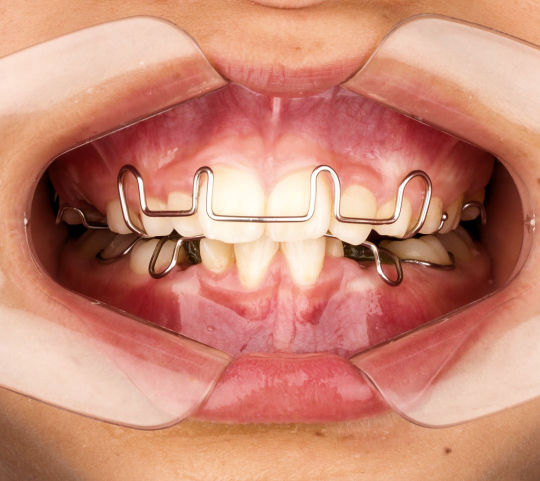
#braces#orthodontics#orthodontic correction#removable appliances#orthodontic retainers#close up#dental clinic#orthodoncia#pretty mouth
5 notes
·
View notes
Text
Assisted Living & Caretaking - Please Read ‼️
Hello, this is extremely difficult and embarrassing for me to post, but my disabled grandma was recently dumped on the street and is in my care until she is approved to be transitioned into assisted living which I cannot afford on my own, nor can I afford to take care of her by myself in the meantime, or to get her the essentials she needs and does not have at this time. We’re currently in the process of getting her approved for disability, but I don’t know when or what kind of aid we’ll receive. She has already been receiving SSI benefits and EBT, however her last caretaker was using them fraudulently for their own pleasure (this is in the process of being reported as well) and have already been drained for the month, not being recharged until next month. Due to the length of the situation, I’ve included the details and link to a GoFundMe I’ve made under the readmore. Please do not feel obligated to donate if you are unable to do so, I do not want anyone to feel guilted into supporting me, or to financially hurt themselves just to be kind.
My 64 year old grandma was found abandoned wandering around a nearby neighborhood around 9 am this morning. Thankfully someone was kind enough to (safely) coax her into a car and call any numbers she could after charging her phone for her. After calling my younger sibling, who then called me later, she was unable to help any further and dropped my grandma off at a nearby grocery store per the (unfortunate) request of my sibling.
She was dumped by her son around 9 pm, an ambulance was called when somebody else saw her wandering aimlessly alone in the dark and cold weather, which she then eloped from the hospital with the IV in her arm until she was found like described above.
None of her children will take her in under their care, and have even threatened to dump her again if put back in their care. Adult Protective Services are involved, but I don’t currently know if the case will be investigated any further.
My grandma has stroke related dementia, a permanent walking disability due to her repetitive strokes and head injuries, and extreme arthritis. To express the extent of her current dementia, I’ll share that she eloped from the hospital with the IV still in her arm and couldn’t recall why it was in her arm and thought she had it for over a week (and that it was jewelry before attempting to unsafely remove it herself), and she is in the early stages of doing things like misusing appliances, asking questions out of context, and not recognizing very familiar faces. (Repeatedly asked who my childhood best friend was who she has know since they were 13).
She is currently staying in my room until we find her an assisted living complex, but was also abandoned with no essentials. She is unable to eat certain foods due to the fact her partial was lost while in their care, and currently has no dental or medical (we are in the process of changing that), and was only left with 2 garbage bags of clothes that mostly have holes (including the extremely few pairs of underwear and socks she has).
Anything donated will go towards getting her essentials (clothes, food, hygienic products, etc.), any medical and dental expenses, any assisted living costs, and making my home a safe space for her disabilities until she is transitioned out and into assisted living (installing locks on cupboards for appliances and sharp kitchen tools, covering sharp corners, hand rail in our long hallway, modifying our stand in shower/getting a sitting situation for her to bathe comfortably and independently in, etc.)
Thankfully I am waiting for a promotion and pay raise from my current job, so this financial need will hopefully be temporary.
Anything helps and I appreciate you taking the time to read and/or share.
91 notes
·
View notes
Photo


It’s dark, and it needs work. But, it’s got some great features, and the real estate ad says it can possibly be used for a business (noooooo, not an office!). This 1900 Victorian is located in Macomb, Illinois, has 3bd. 2.5ba, and is listed for only $107K. Give it a look.

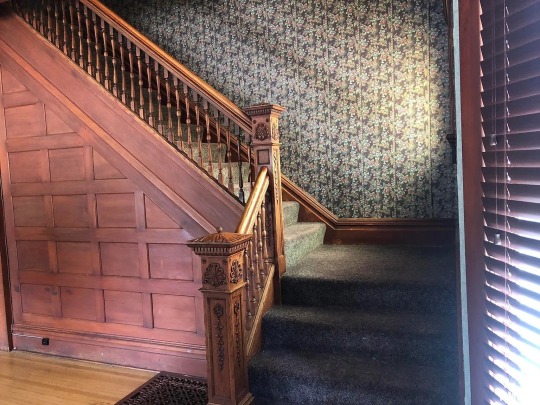
The first thing we see as we enter is beautiful original wood & floors. I would like to see what’s under that carpet and the wood wall looks like it’s been stripped and re-stained, so it needs some sealer.

You can just see a glimpse of the beautiful ceiling millwork.
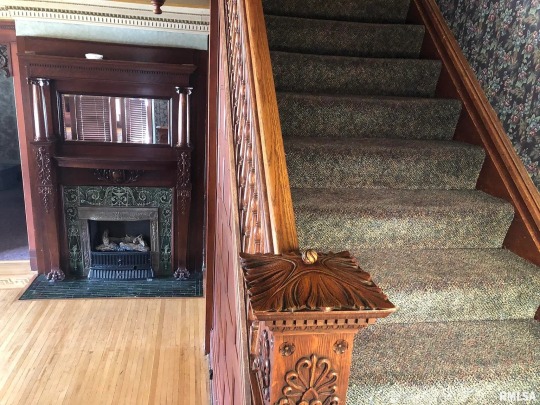
Wow, gorgeous fireplace. Also, the carpet really matches the wallpaper. It could stay awhile.
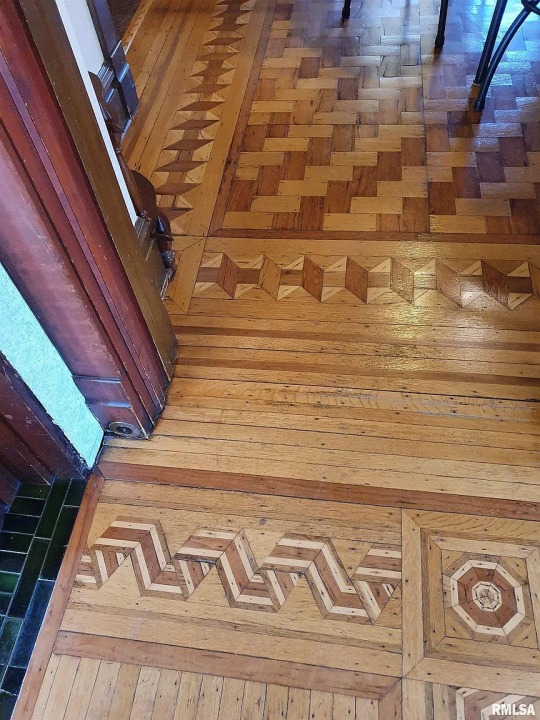
Look at the fabulous floors. Love that.

Windows w/original wood- look at that dental crown molding! I don’t think that the tiny corbels are original, though.

Gold ceiling, medallion and beautiful chandelier. Love the door and columns. It’s dark, but there’s some lovely millwork on the right.
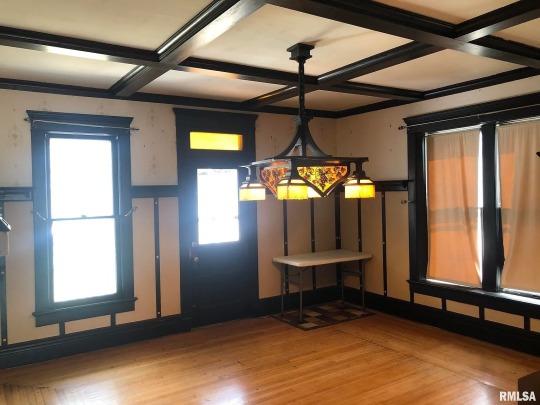

Another original door, ceiling beams, and a cool light fixture. Love the walls, too. Must be the dining room.

You can see that gorgeous fireplace from here and look at the size of the crown molding.

Wow, the windows in the turret out front. Look at the beautifully detailed crown molding.
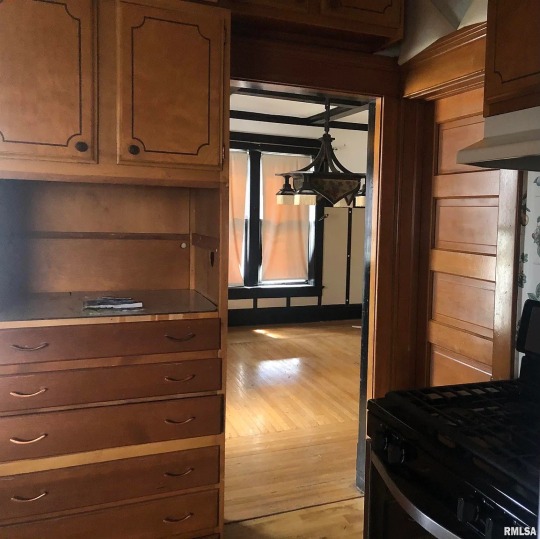



Hmmm...looks like a picnic bench up there. Don’t like the kitchen, it’s a dated reno, but it’s not urgent. It’s still a useable kitchen for now. Plus, the appliances are new.

This bathroom has been painted over, and it would look great with reproduction Victorian plumbing fixtures.
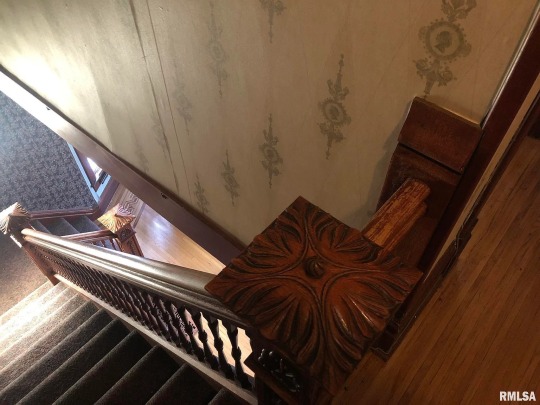
There’s a lot of wallpaper in this house. Some of it should be removed, which is a lot of work.

The hall to the bedrooms still has the original gas light fixture on the wall.

Not lovin’ the shower, but the pedestal sink is cool.

This bd. needs some sprucing up.

Bd. set up as a family room. Loving all the original doors.

Why do they keep it so dark? Open the shades. Looks like a nice new floor in here.

Is that a grapevine? I LOVE grapevines. My grandparents had one and I couldn’t get enough of those sweet Concord grapes.

Nice little porch on the back.

Large yard with a garage.

Oh, how can you resist this? Look at how pretty she is. I hope an office doesn’t buy it, it needs to stay a house.
https://www.century21.com/property/501-n-lafayette-street-macomb-il-61455-C2182973690
#victorian house#victorian architecture#handyman special#houses#old house dreams#house tours#home tour
217 notes
·
View notes
Text
How Often (and When) Should You Floss?
The American Dental Association (ADA) recommends that you clean between your teeth using floss, or an alternative interdental cleaner, once each day. They also recommend that you brush your teeth twice a day for 2 minutes with fluoride toothpaste.
Why should I floss?
Your toothbrush can’t reach between your teeth to remove plaque (a sticky film that contains bacteria). Flossing gets between your teeth to clean away the plaque.
By flossing and brushing your teeth, you’re removing plaque and the bacteria in it that feeds on sugar and particles of food that remain in your mouth after eating.
When the bacteria feed, they release an acid that can eat away at your enamel (the hard outer shell of your teeth) and cause cavities.
Also, plaque that isn’t cleaned away can eventually harden into calculus (tartar) that can collect on your gumline and lead to gingivitis and gum disease.
When should I floss?
The ADA suggests that the best time to floss is the time that comfortably fits into your schedule.
While some people like to include flossing as part of their morning ritual and start the day with a clean mouth, others prefer flossing before bedtime so they go to bed with a clean mouth.
Should I brush or floss first?
It doesn’t matter if you brush or floss first, as long as you do a thorough job cleaning all of your teeth and practice good oral hygiene habits every day.
A 2018 studyTrusted Source suggested that it’s better to floss first and then brush. The study indicated that flossing first loosened bacteria and debris from between teeth, and brushing afterward cleaned these particles away.
Brushing second also increased fluoride concentration in the interdental plaque, which could reduce the risk of tooth decay by strengthening tooth enamel.
However, the ADA maintains that either flossing first or brushing first is acceptable, depending on what you prefer.
Can I floss too much?
No, you can’t floss too much unless you’re flossing incorrectly. If you apply too much pressure when you floss, or if you floss too vigorously, you may damage your teeth and gums.
You may need to floss more than once a day, especially after meals, to clean out food or debris that’s stuck between your teeth.
Are there alternatives to flossing?
Flossing is considered interdental cleaning. It helps remove interproximal dental plaque (the plaque that collects between teeth). It also helps remove debris, such as food particles.
Tools for interdental cleaning include:
dental floss (waxed or unwaxed)
dental tape
pre-threaded flossers
water flossers
powered air flossers
wooden or plastic picks
tiny flossing brushes (proxy brushes)
Talk to your dentist to see which is best for you. Find one that you like and use it regularly.
Flossing with braces
Braces are appliances applied to your teeth by an orthodontist to:
straighten teeth
close gaps between teeth
correct bite problems
align teeth and lips properly
If you have braces, the Mayo Clinic and the American Association of Orthodontists recommend:
cutting back on starchy and sugary foods and beverages that contribute to plaque formation
brushing after every meal to clear food particles from your braces
rinsing thoroughly to clear the food particles the brush left behind
using a fluoride rinse, if it’s been recommended by your orthodontist or dentist
flossing regularly and thoroughly to maintain excellent oral health
When flossing with braces, there are some tools to consider using:
floss threader, which gets floss under wires
waxed floss, which is less likely to catch on braces
water flosser, an interdental flossing tool that uses water
interdental flossing brushes, which clean out debris and plaque that get caught on brackets and wires, and in between teeth
Takeaway
The American Dental Association suggests that you brush your teeth twice a day — about 2 minutes with a fluoride toothpaste — and use an interdental cleaner, such as floss, once a day. You can floss before or after you brush.
In addition to home brushing and flossing, schedule regular visits with your dentist to identify potential dental problems early, when treatment is commonly simpler and more affordable.
22 notes
·
View notes
Text
My tooth moved so much while I was sleeping.
Explanation:
So basically two years ago, I had to get my canines pulled because they wouldn’t get loose or anything. THEN I went a whole GODDAMN year without canines, which was fine and I grew to actually like my smile.
Then last year, i had to get oral surgery, because apparently my adult canines decided to be little brats and stop moving. Funny thing about that, is my left canines wasn’t even in the right spot, it was like a good ways in my mouth, so they had to remove a bunch of tissue in inside my mouth so they can move the tooth into place. My right tooth just had to be pulled down into place.
Yesterday, they finally put a bracket on my right tooth, cause it’s far enough down. And let me tell you- that tooth moved so much last night like- what? It feels so weird, cause I usually bite my tongue on that side, and there was a small little like- hole, we’ll call it. But now, it’s literally in line with all my other teeth-
My left tooth however, still isn’t close enough to my other teeth to put a bracket on, because there’s still a lot of gum tissue or whatever. So this time instead of giving me a goddamn spring, and connecting a separate wire through the little tooth thing they put on, they were smart enough to put the wire through it, so now it’ll move a bit towards my teeth.
The next part makes me laugh because it’s hella funny. So they gave me a herbst appliance, which moves my jaw to fix an overbite. Let me tell you how fucked up my jaw was- they couldn’t fit any more adjustment things on my herbst- LIKE GODDAMN HOW FUCKED UP IS MY JAW!? It’s okay though, because the actual dentist guy said the two adjustments the lady gave me was fine.
That’s my dental story, keep it locked up tight.
“BUT I STILL DONT UNDERSTAND!”
Enough, alright. Once upon a time, I had a fucked up mouth, and I’ve been through lots of pain :D
#dentist#orthodontics#braces#surgery#oral surgery#teeth pulled#tuck everlasting#my jaw is fucked up#my mouth is also fucked up
6 notes
·
View notes
Text
100 Quirky Fun Life Hacks
1. Use a paper clip to fix a broken zipper pull.
2. Freeze grapes to chill white wine without diluting it.
3. Store bed sheets inside their matching pillowcase.
4. Use a trousers hanger as a cookbook holder.
5. Put a wooden spoon over boiling water to prevent overflows.
6. Use muffin tins for condiment assortments at BBQs.
7. Place a rubber band around an open paint can to wipe your brush.
8. Use nail polish to differentiate keys.
9. Cut soft cheese or cake with unscented dental floss.
10. Use a squeegee to remove pet hair from furniture.
11. Put pancake mix in a ketchup bottle for a no-mess experience.
12. Use old newspaper to deodorize food containers.
13. Clean your keyboard with sticky notes.
14. Use a can opener to safely open blister packs.
15. Amplify your phone’s speaker with a cup.
16. Use ice cubes to remove furniture indentations in carpet.
17. Use a banana peel to shine shoes.
18. Put a dry towel in the dryer to speed up the drying process.
19. Use a hanging shoe rack to organize cleaning supplies.
20. Use toothpaste to clear up hazy car headlights.
21. Drop Alka-Seltzer tabs to clean a toilet.
22. Freeze aloe vera gel in ice cube trays for sunburn relief.
23. Store ice cream in a zip-top bag to keep it soft.
24. Use a bread tab to hold your spot on a roll of tape.
25. Thread a necklace through a straw to prevent tangling.
26. Blow-dry your mirror to prevent fogging.
27. Use a pool noodle to fill your mop bucket.
28. Use a tennis ball to hold pens or as a towel holder.
29. Clean sneakers with toothpaste.
30. Use a lint roller to clean out your purse or backpack.
31. Use a pasta ladle to measure one serving of spaghetti.
32. Use a pillowcase to clean ceiling fans.
33. Place a rubber band around an open paint can to wipe your brush.
34. Use a post-it note when drilling to catch dust.
35. Wrap gifts with fabric for reusable wrapping.
36. Flip a toaster on its side for grilled cheese.
37. Prevent pot boiling over with a wooden spoon.
38. Infuse olive oil with garlic for instant bread dip.
39. Freeze lemon slices and water for instant refreshing drinks.
40. Use a hair straightener to iron collar edges.
41. Cook two pizzas at once by cutting them in half and laying them flat.
42. Use a microfiber cloth to clean your glasses with vinegar.
43. Use a carabiner to carry multiple grocery bags.
44. Freeze a sponge in a zip bag for an ice pack that won’t drip.
45. Write with a whiteboard marker on appliances to track perishables.
46. Use an egg slicer for equally sliced mushrooms.
47. Put a damp sponge in the microwave to disinfect it.
48. Layer scented dryer sheets between sheets for a fresh bed.
49. Soak a sponge in water and soap, freeze it for a DIY ice pack that cleans.
50. Use binder clips to fix a broken keyboard foot.
51. Make a tablet stand from a cutting board and a scrunchie.
52. Stash emergency cash in a ChapStick tube.
53. Plant herbs in a wine rack with glass jars.
54. Organize cables with binder clips on a desk edge.
55. Clean blender by blending water and soap.
56. Stuff newspaper in wet shoes for quick drying.
57. Use a muffin tin to serve condiments at a picnic.
58. Turn a magazine holder into a shelf by mounting it sideways.
59. Keep apple slices from browning with a rubber band.
60. Use a plastic bottle as a makeshift watering can.
61. Drop a few marshmallows into brown sugar to prevent hardening.
62. Clean your iron by ironing salt on wax paper.
63. Use a vegetable peeler to slice cheese thinly.
64. Sharpen scissors by cutting fine-grit sandpaper.
65. Use crayons as emergency candles.
66. Place a wooden spoon in a pot to prevent boiling over.
67. Make your own ice pack by freezing dish soap.
68. Organize your closet by hanging bags with shower curtain rings.
69. Keep cords organized with bread tags.
70. Use a colander to evenly distribute powdered sugar.
71. Make a DIY sprinkler with a punctured plastic bottle.
72. Use a wine cork to safely store needles.
73. Store sheet sets inside their corresponding pillowcase.
74. Freeze coffee in ice cube trays for undiluted iced coffee.
75. Use beeswax to waterproof shoes.
76. Use a magnetic strip to organize bobby pins and tweezers.
77. Remove pet hair with a squeegee.
78. Use old CD racks for bagel sandwich holders.
79. Use a potato to unscrew a broken lightbulb.
80. Use a salad spinner to fluff down jackets.
81. Use glasses as a makeshift smartphone tripod.
82. Keep your earbuds in a mint container when not in use.
83. Seal plastic bags with the top of a water bottle; cut the top off and slide the bag through the neck.
84. Convert a cardboard box into a makeshift sled.
85. Turn a plastic bottle into a makeshift piggy bank.
86. Keep a bar of soap in the same drawer as your dirty laundry to keep it smelling fresh.
87. Use old socks as sleeves to protect drinks from warming or hands from cold.
88. Use a wine bottle as a rolling pin.
89. Make a no-sew pet bed from an old sweater.
90. Cut an old milk jug into a dustpan.
91. Use a yoga mat under rugs for extra no-slip safety.
92. Use a waffle iron to make cinnamon rolls.
93. Turn a bread clip into a holder for tapes on a tape roll.
94. Put Vaseline on the end of a nail polish bottle for easy opening.
95. Use a vegetable peeler to make chocolate curls.
96. Use a pill container to organize jewelry when traveling.
97. Use a shower cap to cover the bottom of shoes in your luggage.
98. Use a lemon to freshen up your garbage disposal.
99. Use a rubber band around an open paint can for excess paint wiping.
100. Use clear nail polish to stop a run in your stockings.
2 notes
·
View notes
Text
Finding Emergency Dental Services in Winnipeg
Dental emergencies can strike unexpectedly, often causing intense pain or discomfort that requires immediate attention. Whether it's a sudden toothache, a chipped tooth from an accident, or issues with dental appliances, knowing where to find Emergency Dental Services Winnipeg is crucial. Quick, professional dental care can prevent a minor issue from escalating into a more serious health concern. Here’s a guide to help you understand when and how to seek emergency dental services in Winnipeg, along with tips to handle dental emergencies in the meantime.
Common Dental Emergencies
Some of the most common dental emergencies include:
Severe Toothache: A persistent or intense toothache could be a sign of an infection or decay reaching deep into the tooth’s root. If left untreated, this can lead to more serious complications, including abscess formation or the spread of infection.
Chipped or Broken Teeth: Whether it’s due to an accident, sports injury, or biting into something hard, chipped or broken teeth can cause discomfort and even lead to infection if not treated promptly.
Knocked-Out Tooth: Losing a tooth due to trauma is a dental emergency that requires immediate action. If handled quickly, there’s a chance the tooth can be reinserted by a professional.
Lost Filling or Crown: When a filling or crown falls out, the exposed tooth can become sensitive, causing discomfort and increasing the risk of infection. Emergency dental services can replace or repair the crown or filling to protect the tooth.
Abscess: A dental abscess is a severe infection around the tooth's root or gum that requires immediate attention. Symptoms include swelling, fever, and intense pain. Left untreated, abscesses can lead to more severe infections and health risks.
Broken or Loose Dental Appliances: Braces, retainers, and other dental appliances can become loose or broken, causing discomfort and affecting your dental health. Quick repairs can prevent further damage to teeth and surrounding areas.
When to Seek Emergency Dental Services
A good rule of thumb for determining if you need Emergency Dental Care Winnipeg is to ask yourself if the problem is causing pain, swelling, or infection. If the answer is yes, then you likely need immediate attention. However, some non-urgent issues, like a dull toothache or mild sensitivity, may not require an emergency visit. If in doubt, contact a dental office for guidance. Many clinics in Winnipeg have dedicated staff to advise you on whether your issue qualifies as an emergency and to schedule an appointment if needed.
Finding Emergency Dental Clinics in Winnipeg
Winnipeg has numerous dental clinics, many of which offer emergency services. Some clinics operate during standard business hours with emergency appointments available, while others provide extended hours, including evenings and weekends. It’s a good idea to research local dental clinics and have their contact information on hand in case of an emergency. Additionally, some facilities offer 24/7 phone consultations to determine if immediate care is necessary.
What to Do in a Dental Emergency
While waiting to see a dentist, here are a few first-aid tips to manage pain and reduce damage:
Toothache: Rinse your mouth with warm water and gently floss around the affected tooth to remove any food particles. Avoid putting aspirin directly on the gum, as this can cause irritation.
Broken Tooth: Rinse your mouth with warm salt water and apply a cold compress to the outside of your cheek to reduce swelling.
Knocked-Out Tooth: Rinse the tooth carefully (without scrubbing) and try to place it back in the socket. If that’s not possible, store it in milk until you can reach a dentist.
0 notes
Text
Dental Labs in Liberal, KS: A Vital Link to Quality Oral Care
When it comes to maintaining oral health, many people think of the dentist as the primary healthcare provider. However, behind every successful dental procedure, there is often a skilled dental lab technician. In Liberal, Kansas, Dental Lab Liberal Ks play an essential role in ensuring that patients receive high-quality dental restorations, such as crowns, bridges, dentures, and other prosthetics.
The Role of Dental Labs
A dental lab is a specialized facility where dental technicians work to fabricate and repair dental devices based on the prescriptions provided by dentists. These devices are often essential for patients who need replacements for missing teeth, or adjustments to their existing dental work. For example, crowns are used to restore damaged teeth, while dentures help replace missing teeth for those who may have lost some or all of their natural teeth.
The dental lab technicians in Liberal, KS, collaborate closely with local dentists to create custom dental appliances that fit precisely and comfortably, contributing to the overall success of the treatment. Their work requires both technical skill and artistic flair, as each restoration needs to look natural while meeting the functional requirements of the patient's mouth.
Services Offered by Dental Labs
In Liberal, dental labs typically offer a variety of services aimed at improving oral health and enhancing a patient's smile. These services include:
Crowns and Bridges – Crowns are often used to cover damaged teeth, while bridges replace missing teeth by anchoring onto adjacent teeth. Both are crafted to match the patient’s natural teeth for a seamless appearance.
Dentures and Partials – Dentures are removable replacements for missing teeth. Full dentures replace an entire row of teeth, while partial dentures are used when only some teeth are missing. The dental lab customizes dentures for fit, comfort, and aesthetics.
Veneers – Thin layers of porcelain or composite resin are bonded to the front of teeth to correct cosmetic issues like discoloration, chips, or gaps. Dental labs ensure that veneers are crafted to match the patient’s natural tooth color and shape.
Implant Restorations – Dental implants provide a long-lasting solution for missing teeth. Dental labs design custom implant restorations that fit securely onto the titanium posts placed in the jaw, restoring both function and appearance.
Retainers and Night Guards – Retainers help maintain the position of teeth after orthodontic treatment, while night guards are used to prevent damage caused by teeth grinding (bruxism). Dental labs fabricate these devices based on impressions taken by the dentist.
Quality and Precision in Every Step
One of the key factors that set dental labs in Liberal apart is their commitment to quality and precision. Dental technicians rely on their extensive training and advanced technology to ensure that each restoration fits properly and looks natural. This level of detail helps minimize the chances of discomfort or adjustments later on, leading to better outcomes for patients.
Additionally, many dental labs offer personalized services, working closely with patients' dentists to meet specific needs or requests. This personalized approach ensures that the final product isn’t just functional but also aesthetically pleasing, which is particularly important for visible teeth restorations.
Why Local Dental Labs Matter
Choosing a local Dental Lab Hays Ks, offers several benefits. Proximity allows for quicker turnaround times, reducing wait periods for dental restorations. Local labs are also more likely to have a vested interest in the community’s health and well-being, making them a trusted partner for local dentists and patients alike.
0 notes
Text
Complete Dentures & Partial Dentures in Pimple Saudagar
The Denture is a removable replacement for missing teeth and surrounding tissues. Two types of dentures are available — complete and partial dentures. Complete dentures are used when all the teeth are missing, while partial dentures are used when some natural teeth remain.
Complete Dentures
Complete dentures can be either “conventional” or “immediate.” Made after the teeth have been removed and the gum tissue has begun to heal, a conventional denture is ready for placement in the mouth about 8 to 12 weeks after the teeth have been removed.
Unlike conventional dentures, immediate dentures are made in advance and can be positioned as soon as the teeth are removed. As a result, the wearer does not have to be without teeth during the healing period. However, bones and gums shrink over time, especially during the healing period following tooth removal. Therefore a disadvantage of immediate dentures compared with conventional dentures is that they require more adjustments to fit properly during the healing process and generally should only be considered a temporary solution until conventional dentures can be made.
Partial Dentures
A removable partial denture or bridge usually consists of replacement teeth attached to a pink or gum-colored plastic base, which is connected by metal framework that holds the denture in place in the mouth. Partial dentures are used when one or more natural teeth remain in the upper or lower jaw. A fixed (permanent) bridge replaces one or more teeth by placing crowns on the teeth on either side of the space and attaching artificial teeth to them. This “bridge” is then cemented into place. Not only does a partial denture fill in the spaces created by missing teeth, it prevents other teeth from changing position. A precision partial denture is removable and has internal attachments rather than clasps that attach to the adjacent crowns. This is a more natural-looking appliance.
Dental Implants can be used to support permanently cemented bridges, eliminating the need for a denture. The cost is usually greater, but the implants and bridges more closely resemble the feel of real teeth. Dental implants are becoming the alternative to dentures but not everyone is a candidate for implants.
Ensure optimal oral health by seeking advice from your dentist. Regular check-ups and personalized guidance are essential for maintaining a healthy smile. Trust the expertise of the Best Dentist in Pimple Saudagar – Dr. Shirish Yadav for comprehensive dental care.

Vallplast or Flexible Dentures with warranty
Valplast refers to the flexible, pressure-injected base, which is perfect for partial dentures. They are practically indiscernible, lightweight and amazingly comfortable. It is made from thermoplastic nylon that is biocompatible and making patients highly pleased for more than 5 decades. They are easy and fast to make saving your patients the great deal of wait.
Our team highly recommends Valplast flexible partial dentures for people who opt for comfortable and quick final restoration. Although the cost is a bit higher in contrast to other partial dentures that come with metal clasps, the results are very satisfactory and elegantly beautiful – exactly what every client wants. Most importantly, the process is non-invasive making it a great choice.
Dentists are prescribing Valplast Flexible Partials because it makes a better, stronger appliance faster. The strong, flexible nature of Valplast is perfectly suited to the variety of natural conditions in the mouth, simplifying design and enabling the flexible nylon resin to act as a built in stressbreaker in order to provide superior function and stress distribution in a removable partial denture.
Valplast is one of the most cosmetic, comfortable and affordable methods of tooth replacement, Visit the Dental Clinic in Pimple Saudagar for top-notch care.
0 notes
Text
Understanding Orthodontic Treatment

Orthodontic treatment is a branch of dentistry that focuses on correcting misaligned teeth and jaws to improve oral health and aesthetics. Misaligned teeth can lead to various issues such as difficulty in chewing, speech problems, and increased risk of gum disease. Orthodontic treatment aims to straighten teeth, improve bite function, and enhance overall oral health.
There are several types of orthodontic treatment options available, including traditional braces, clear aligners, and retainers. Traditional braces consist of metal brackets and wires that are attached to the teeth to gradually move them into the desired position. Clear aligners are a popular alternative to traditional braces 千葉市 矯正歯科, as they are virtually invisible and can be removed for eating and cleaning. Retainers are often used after orthodontic treatment to maintain the results and prevent teeth from shifting back to their original positions.
Orthodontic treatment typically begins with a consultation with an orthodontist, who will assess the patient's teeth and jaw alignment to determine the most appropriate treatment plan. The duration of orthodontic treatment varies depending on the severity of the misalignment and the chosen treatment method. Patients are advised to follow all instructions provided by their orthodontist, including wearing their appliances as directed and attending regular appointments for adjustments.
Overall, orthodontic treatment can have a significant impact on a person's oral health and confidence. Straightening misaligned teeth not only improves the appearance of the smile but also enhances bite function and reduces the risk of dental problems. If you are considering orthodontic treatment, consult with an orthodontist to discuss your options and create a personalized treatment plan that meets your needs and goals.
0 notes
Text
Interested in fixing minor tooth alignment issues discreetly? Removable orthodontic braces offer subtle straightening treatment options from experienced London clinics like 1A Orthodontics. Read on for essential details on how clear alternative appliances straighten smiles subtly yet effectively for all ages.
#removable orthodontic retainer#removable orthodontic braces#cost of removable retainers#removable appliance#removable orthodontic appliances#removable dental appliance
0 notes
Text
What To Expect During Your First Visit To An Orthodontist?
Embarking on your journey to a straighter smile can be exciting and nerve-wracking, especially if you are visiting an orthodontist Auckland professional for the first time. Understanding what to expect during your initial consultation can help ease any apprehensions.
This blog will guide you through the key elements of your first visit, ensuring you feel well-prepared and informed as you take this important step toward enhancing your dental health.
The Initial Consultation: Establishing Your Foundation
Your first appointment with an orthodontist will primarily focus on gathering information and establishing a foundation for your treatment. Upon arrival, you will be welcomed by the clinic staff, who will assist you with any necessary paperwork.
This may include your dental and medical history, which is crucial for the orthodontist to understand your overall health and any specific concerns.
During the consultation, the orthodontist will discuss your dental history, lifestyle, and any issues you may have noticed regarding your teeth or bite. This dialogue is essential to creating a personalised treatment plan tailored to your needs.
A Comprehensive Examination: Assessing Your Oral Health
Following the initial consultation, the orthodontist will thoroughly examine your teeth and jaws. This process typically includes:
Visual Inspection: The orthodontist will examine your teeth for alignment, spacing, and occlusion (how your upper and lower teeth fit together).
Digital Imaging: The orthodontist may take digital X-rays and photographs to better understand your dental structure. These images are instrumental in diagnosing any underlying issues and formulating an effective treatment plan.
Bite Evaluation: A bite analysis may assess how your teeth come together and whether any functional concerns need to be addressed.
This examination allows the orthodontist to determine the best treatment options for your specific case, whether that involves braces, clear aligners, or other orthodontic appliances.

Understanding Your Treatment Options: Tailored Recommendations
After the examination, the orthodontist Auckland expert will discuss the findings and present you with various treatment options. They will explain the various types of orthodontic appliances available, including:
Traditional Metal Braces: These are the most common braces and consist of metal brackets and wires.
Ceramic Braces: Similar to metal braces but made from clear materials, making them less noticeable.
Lingual Braces: Placed on the backside of the teeth, making them virtually invisible.
Clear Aligners: Such as Invisalign, which are removable and offer a discreet option for teeth straightening.
Additionally, the orthodontist will outline the expected duration of your treatment, which can vary significantly based on individual needs. Understanding the timeline is essential for setting realistic expectations.
Financial Considerations: Discussing Costs and Payment Plans
Orthodontic treatment is an investment in your dental health and overall well-being. During your consultation, the orthodontist Auckland consultant will discuss the costs associated with your recommended treatment plan.
They will provide information on available financing options and payment plans, making it easier to manage your budget while receiving the care you need.
Taking the Next Steps: Initiating Treatment
If you and your orthodontist decide to proceed with treatment, your next appointment will typically involve further preparations. This may include taking impressions of your teeth or fitting you for braces or aligners.
Before leaving, your orthodontist will provide detailed care instructions, including dietary recommendations and tips for maintaining proper oral hygiene during your treatment.
Conclusion: A Positive Step Towards Your Smile
Visiting an orthodontist Auckland clinic for the first time is crucial to achieving the smile you desire. You can confidently approach your appointment by understanding what to expect during your initial consultation.
Remember that your orthodontist is there to support you throughout your treatment journey, so feel free to ask questions and share any concerns you may have.
As you embark on this path toward improved oral health, rest assured that a beautiful, confident smile is well within your reach.
Source by - https://shorturl.at/R71f7
0 notes
Text
Top Reasons to Consider Orthodontic Treatment Richmond
Orthodontic Treatment Richmond is a great option towards the beauty and health of the smile. Richmond Family Dental is pleased to mention that they have orthodontists who are dedicated to improving their patients’ smiles by ensuring that their teeth are well-aligned. Irrespective of whether it involves crooked teeth, dental gaps or the particulars host of a bite, our orthodontic specialist will ensure you are guided from A to Z in all your orthodontic concerns.

What is Orthodontic Treatment?
The correction of teeth and jaws is the main, and often the ultimate focus, of orthodontics procedures. This particular branch of dentistry aims to correct the position of irregularly arranged teeth or malocclusions such as overcrowding, gaps, overbites, underbites, and crossbites. An experienced Orthodontic Treatment Richmond will implement braces, clear aligners and other innovative appliances to precisely reposition your teeth. The purpose of orthodontic treatment, more than enhancing your smile, is to make the oral cavity easier to clean and maintain by modernizing the arrangement of the teeth.
Common Orthodontic Issues
There is a common misconception among people that orthodontics is only involved on issues of cosmetic enhancement but the truth is that it has other functions as well which improve dental health. Orthodontic treatment in Richmond helps to solve the following common problems:
Bulging Teeth: Whenever the jaws are small for the number of teeth in the mouth, such teeth are prone to overlapping one another. This makes the teeth out of line or distorted in a way that maintaining the mouth clean as it should be is very challenging.
Occasional Bite: Misaligned bites including overbite, underbite and crossbites that are misaligned in the jaw can be very painful and they can limit the ability of the jaw to function properly leading to pain and at times, speech difficulties.
Spaces and Gaps: Teeth spacing may also be caused by the absence of a tooth or having a larger than normal jaw. This could ruin one’s smile and act as a cavity for food.
Teeth Misalignments: Whenever some teeth are excluded wrongly, it may hinder other orofacial functions that include chewing and even speaking hence it may cause dental problems.
Types of Orthodontic Treatment at Richmond Family Dental
At Richmond Family Dental we have a wide range of orthodontic treatment methods for every case. Our experienced Richmond orthodontists will assess your dental situation and offer the most appropriate treatment plan for you. Here are the basic types of orthodontic treatments offered:
Traditional Metal Braces The old fashioned solution to most dental alignment complications is the traditional metal braces. They comprise of metal brackets and wires which are regularly adjusted to enable the teeth move to the desired position. They are more visible than other options but today’s metal braces are smaller than what they were and are more comfortable than ever. They are the most efficient means of treatment and can correct even the most severe cases of misalignment.
Transparent Braces Transparent braces are constructed using clear or tooth-hued items and even functions the same way metal braces does. It is the most commonly preferred braces for adults and teenagers who wish to wear brackets without the fear of other people noticing them. Clear braces are not less effective than any other traditional braces and do the job quite well.
Invisalign Invisalign has gained immense popularity amongst people who wish to correct their teeth alignment without anybody noticing. This treatment is based on a succession of or clear removable aligners created for the shape of the patient’s teeth. This aligner is flexible and allows the patient to carry it out when out for a meal, having a drink, brushing, or flossing. It helps anyone who desires the changes in their teeth alignment and is not for the purpose of wearing traditional braces.
Retainers Retainers are devices used after orthodontics treatment in order to keep the position of the teeth that have been reached at. They are made so as to fit in one’s mouth comfortably in order to hold the position of the teeth without allowing them to move back to their original positions. Your orthodontist in Richmond will instruct you on the appropriate timespan within which...
Our Process for Orthodontic Treatment in Richmond
In case you want braces fitted or any other Orthodontist Richmond procedure done in Richmond, the first thing that you should do would be to consult an experienced practitioner at Richmond Family Dental for evaluation purposes. This is the stage where your teeth and X-rays will be evaluated and your objectives will be stated. Thus it is at this stage that the orthodontist will be able to come up with a suitable treatment plan for you.
The next step follows once the treatment plan has been determined; it is when you will commence the journey to a more aligned smile.
Why Choose Us?
Richmond Family Dental recognizes the individuality of each smile. We are here to hold your hand to guide you through difficult scenarios – which fortunately we can work on together with you to obtain amazing life-changing smiles that dentistry can offer!Our certified dental nurses, Cassie and Stacey, will be familiar faces who you will meet regularly. They work together with our dentists to cater for your individual needs and to achieve the very best outcome for you in a relaxed, stress-free environment.
We take pride in the environment we provide as patients should feel comfortable and cared for during the whole period of treatment. Irrespective of whether one is a teenager in need of braces or an adult contemplating getting Invisalign, our team is here to help turn your smile aspirations into reality.
Advantages
Orthodontic treatment has many advantages to offer which goes beyond enhancing one’s looks. The positioning of the teeth in its normal position reduces the chances of the teeth getting cavities and the development of gum diseases. Having straight teeth also means that one can chew and speak better thus enhancing the performance of dentistry. In addition, what seems to be just an expense now on orthodontic treatment will in the long run save you time and money through the averting of complex treatment procedures.
Book Consultation Today
If you are looking to improve your smile, do not hesitate to contact us and schedule an appointment for orthodontic consultation at Richmond Family Dental using Telemare. Our trained orthodontist will explain the various treatment types that will be offered courtesy of our clinic and will also be there throughout the process. Therefore, there is no excuse of waiting any further to attain that gorgeous healthy grin that you have always longed for. Contact Richmond Family Dental and begin the wonderful journey of transforming your smile today!
0 notes
Text
Beyond Braces: Transformative Orthodontic Solutions for a Lasting Smile
A beautiful, lasting smile isn’t just about aesthetics; it’s about function, comfort, and lifelong health. While traditional braces are well-known for aligning teeth, orthodontic technology has come a long way, offering various advanced solutions that go beyond braces. At Family Dental Clinic & Implant Center, we provide comprehensive orthodontic care to help you achieve a smile that feels as good as it looks.
The Evolution of Orthodontics: More Than Just Braces
Orthodontics has evolved from the days of metal brackets and wires to a range of innovative solutions. These new treatment options address not only teeth alignment but also jaw positioning, bite correction, and overall facial harmony. Today, orthodontic treatment plans can be customized for comfort, precision, and quicker results, making them accessible to people of all ages.
Clear Aligners: A Discreet, Comfortable Choice
Clear aligners have become a popular alternative to traditional braces, offering a discreet way to straighten teeth. These removable aligners are custom-made for each patient and are virtually invisible. They work by gradually shifting teeth into the desired position without the need for wires or brackets.
Benefits of Clear Aligners:
Aesthetic Appeal: Nearly invisible, aligners provide a subtle solution, especially appealing to adults and teens.
Convenience: Aligners can be removed for eating, brushing, and flossing, making them a flexible choice.
Comfort: Made from smooth plastic, aligners reduce the irritation often associated with metal braces.
Hygiene: Since they are removable, it’s easier to maintain proper oral hygiene, reducing the risk of cavities and gum issues.
Clear aligners work well for mild to moderate cases of misalignment, spacing, or crowding. They’re ideal for patients seeking an effective solution without the noticeable look of braces.
Lingual Braces: The “Invisible” Fixed Solution
For those who need the precision of traditional braces but want a more discreet look, lingual braces offer an alternative. These braces are placed on the inside surface of the teeth, making them invisible from the outside. Lingual braces are highly customizable and suitable for complex cases where other options may not be as effective.
Benefits of Lingual Braces:
Invisible from the Outside: Positioned behind the teeth, they provide a hidden solution for aligning the smile.
Precision: Like traditional braces, lingual braces offer high precision for more complex cases.
Long-Lasting Results: By addressing misalignment comprehensively, lingual braces can lead to lasting outcomes.
Lingual braces are best suited for individuals who want the control and effectiveness of traditional braces but need a more discreet approach.
Self-Ligating Braces: Efficiency and Comfort Combined
Self-ligating braces are an advanced alternative to traditional braces. Instead of elastic bands to hold the wire in place, self-ligating braces use a built-in clip mechanism. This design reduces friction, allowing teeth to move more freely and often more comfortably.
Advantages of Self-Ligating Braces:
Reduced Treatment Time: The lack of friction in self-ligating braces can speed up treatment, requiring fewer adjustments.
Less Pressure: With a clip mechanism, there’s less pressure on teeth, making the process more comfortable.
Easier Maintenance: Self-ligating braces collect less food and plaque, promoting better oral hygiene during treatment.
Self-ligating braces are ideal for patients looking for a faster treatment time with a fixed solution. They’re also easier to keep clean, making them suitable for teens and adults alike.
Functional Appliances: Addressing More Than Just Teeth
For some patients, the primary orthodontic concern is the jaw position rather than just the alignment of teeth. Functional appliances are used in cases where a patient’s jaw structure needs to be adjusted to achieve proper alignment and a balanced bite. These appliances are often used in children and teenagers, as their jaws are still developing.
Key Benefits of Functional Appliances:
Correct Jaw Misalignment: By guiding jaw growth, these appliances can address overbites, underbites, and crossbites.
Improved Facial Profile: Beyond the smile, functional appliances can help create better facial symmetry.
Preventative: Early intervention with functional appliances can reduce or even eliminate the need for more intensive treatment later on.
Functional appliances work best when applied early, helping to shape the developing jaw for optimal alignment and function.
Retainers: The Key to Long-Lasting Results
After completing orthodontic treatment, retainers are essential to maintaining your new smile. Retainers prevent teeth from shifting back to their original position, preserving the results of your treatment.
Types of Retainers:
Fixed Retainers: Bonded to the back of the teeth, these retainers are permanent and ensure that teeth stay in place.
Removable Retainers: These are custom-made and can be taken out for cleaning and eating.
Wearing retainers as instructed is crucial for keeping your smile intact. Retainers provide a simple but effective solution to maintain the hard-earned results of orthodontic treatment.
Why Choose Family Dental Clinic & Implant Center?
At Family Dental Clinic & Implant Center, we believe in providing each patient with an orthodontic solution tailored to their unique needs. Our team of experienced professionals is skilled in the latest orthodontic treatments, and we’re committed to offering a comfortable and stress-free experience. Our clinic’s state-of-the-art infrastructure, including sterilization protocols, ensures a safe and hygienic environment for all procedures.
Schedule Your Orthodontic Consultation Today
Ready to transform your smile with an advanced orthodontic solution? Contact us at Family Dental Clinic & Implant Center to schedule a consultation. Our team will help you choose the right treatment for a confident, healthy, and lasting smile. Call us at 0883 248 0088 or visit our website familydentalclinicrjy.com to learn more about our services. Let’s work together to achieve the smile you’ve always dreamed of!
0 notes
Text
Braces vs. Invisalign: Which Is the Better Option for You?

When it comes to achieving a straighter smile, two popular options stand out: braces and Invisalign. Both are effective cosmetic dental services, but the right choice depends on various factors such as personal preferences, budget, and the complexity of your dental issues. In this post, we’ll compare braces and Invisalign to help you determine which option is better for your specific needs.
Understanding Braces and Invisalign
What Are Braces?
Braces are a traditional orthodontic treatment made of metal brackets and wires that are attached to your teeth. These brackets and wires apply continuous pressure to your teeth, gradually moving them into the desired position.
What Is Invisalign?
Invisalign is a modern alternative to braces that uses clear, removable aligners to straighten teeth. The aligners are custom-made and worn over your teeth, applying gentle pressure to move them into place.
Pros and Cons of Braces
Pros of Braces
Effective for Complex CasesBraces can correct a wide range of dental problems, including severe crowding, gaps, overbites, underbites, and other bite misalignments.
DurabilityBraces are made of durable materials like stainless steel or ceramic, meaning they can withstand the wear and tear of daily life without the need for frequent adjustments.
No Compliance IssuesBraces are fixed to your teeth and you don’t have to worry about removing and forgetting to wear them as you would with Invisalign.
Cons of Braces
AppearanceThe appearance of braces is one of their most significant drawbacks. Metal braces are visible, which may cause self-consciousness for some people.
Dietary RestrictionsBraces come with certain food restrictions, as hard or sticky foods can damage the wires and brackets. Patients need to be cautious when eating to avoid damaging their braces.
DiscomfortBraces can cause discomfort, especially after adjustments. The wires and brackets can irritate the inside of your mouth, leading to sores or discomfort.
Pros and Cons of Invisalign
Pros of Invisalign
Discreet AppearanceOne of the biggest advantages of Invisalign is that the aligners are nearly invisible. This makes them a great choice for adults and teens who want to straighten their teeth without the noticeable look of metal braces.
ComfortInvisalign aligners are smooth and don’t have the brackets or wires that can cause irritation. This often makes them more comfortable to wear.
No Food RestrictionsSince Invisalign aligners are removable, there are no dietary restrictions. You can eat your favorite foods without worrying about damaging your dental appliance.
Cons of Invisalign
Not Suitable for Complex CasesInvisalign is typically recommended for mild to moderate alignment issues. More severe cases may require the precision that only braces can offer.
Discipline RequiredInvisalign aligners need to be worn for 20-22 hours a day to be effective. If not worn as instructed, treatment may take longer than expected or be less effective.
CostInvisalign is often more expensive than traditional braces, though this can vary depending on your location and the complexity of your case.
Which Is the Better Option for You?
Choosing between braces and Invisalign ultimately depends on your specific dental needs and lifestyle. If you have complex alignment issues or don’t want the hassle of remembering to wear aligners, braces may be the better option. On the other hand, if aesthetics and comfort are top priorities, and your dental issues are less severe, Invisalign might be the perfect fit.
Check out more contents:
The Essential Role of Routine Dental Cleanings: What You Need to Know
0 notes